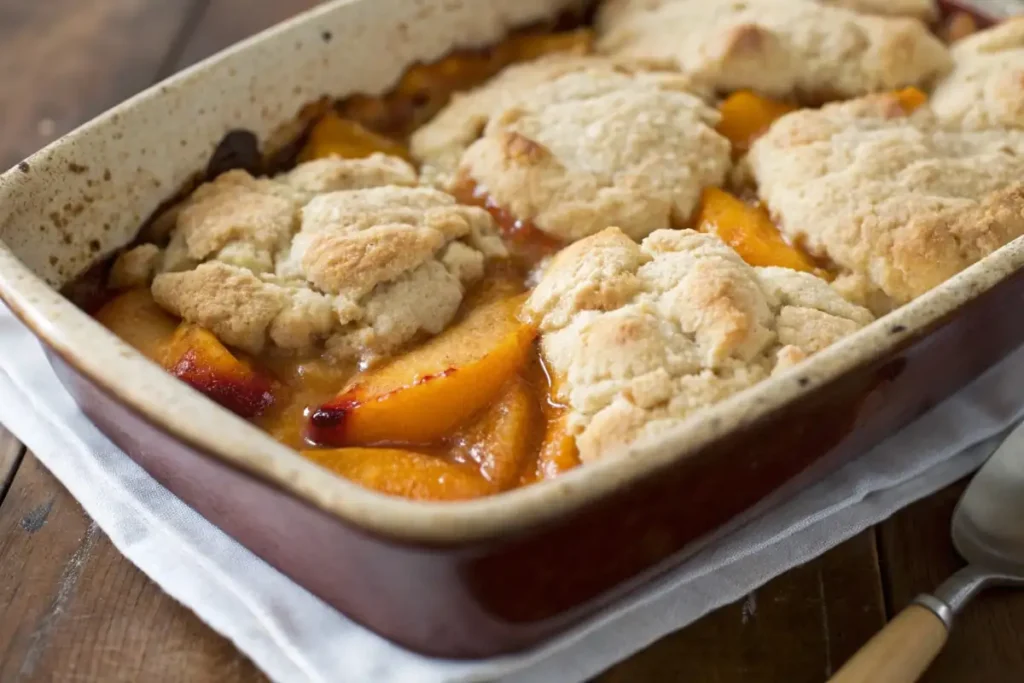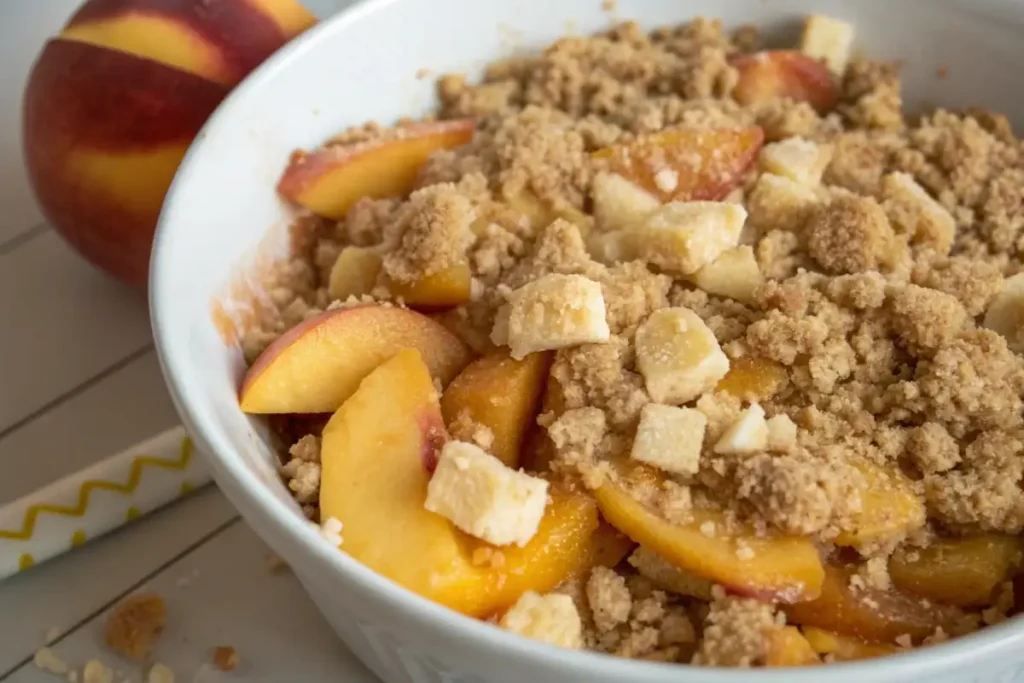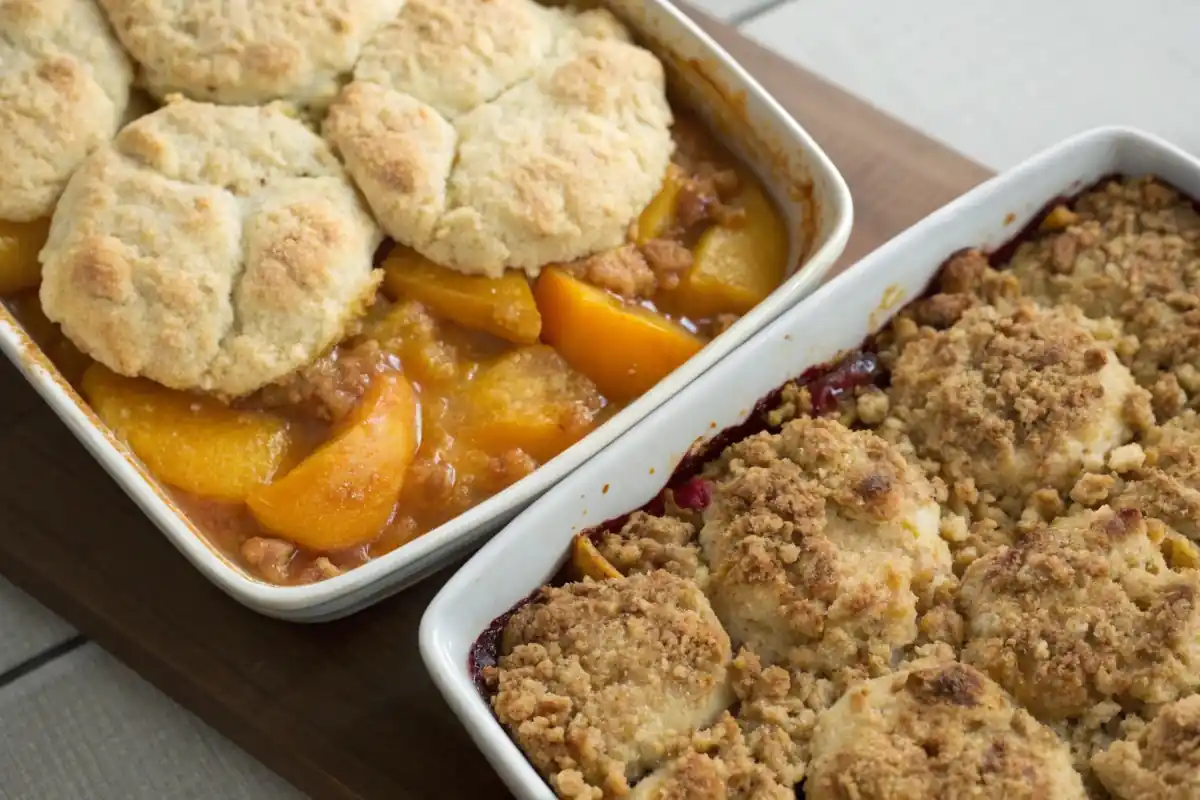Discover how these two classic desserts differ, from their historical origins to modern variations.
Table of Contents
Introduction
Have you ever wondered what’s the difference between a peach cobbler and a crumble? Both desserts feature sweet, juicy fruit layers. However, they have distinct textures and preparation styles. In this article, you will learn about their backgrounds, key characteristics, healthier alternatives, and more. By the end, you will undoubtedly know how to tell these beloved treats apart and make them at home with confidence.
Basics of Peach Cobbler

Peach cobbler is a classic dessert often served piping hot. Basically, it involves ripe peaches at the bottom and a biscuit-like topping over them. This topping can be made with a soft batter or dough. Consequently, when the dessert bakes, the topping develops a golden crust.
Cobblers date back to early American cooking traditions. Initially, settlers adapted recipes from Europe using whatever fruit they had on hand. Peaches eventually became a favorite ingredient because of their natural sweetness and widespread availability in certain regions. Undoubtedly, peach cobbler became popular in the American South, where peach orchards thrived.
Definition and Main Ingredients
- Fresh or canned peaches
- Flour
- Sugar (brown or white)
- Butter
- Baking powder
These fundamental ingredients can be combined in several ways. Comparatively, some bakers prefer a thick biscuit topping. Others opt for a softer batter that spreads over the peaches while baking. Either way, the dessert delivers a comforting, home-style flavor.
Traditional Preparation Steps
- Slice ripe peaches into wedges or cubes.
- Toss them with sugar and a pinch of spices like cinnamon or nutmeg.
- Prepare a dough or batter using flour, butter, and a leavening agent.
- Spread the dough or batter on top of the peaches.
- Bake until the fruit bubbles and the topping turns golden brown.
Notable Variations
- Spiced Peach Cobbler: Incorporates extra cinnamon, nutmeg, and sometimes ginger.
- Southern-Style Cobbler: Features a thick, biscuit-like crust.
- Skillet Cobbler: Baked in a cast-iron skillet for a rustic finish.
Meanwhile, many cooks add citrus zest or extracts like vanilla. Equally, you can experiment with mixed fruits—peaches pair well with berries or nectarines. Altogether, the goal is a bubbly, aromatic dessert that reminds you of comforting family gatherings.
Basics of Crumble

Crumble is another fruit-based dessert that highlights a layer of sweetened fruit underneath a crumbly topping. Hence, the name. In the United States, the topping typically blends flour, sugar, and butter until it forms coarse crumbs. Although peaches are common, many people also use apples, berries, or rhubarb.
Definition and Typical Ingredients
- Chopped fresh fruit (like peaches)
- Flour (sometimes oats are added)
- Sugar
- Cold butter
- Optional flavorings (cinnamon or lemon zest)
Crumble likely originated in Britain. During food rationing, creative home cooks found ways to stretch limited ingredients. Consequently, they developed simple toppings that did not require extra milk or eggs. Eventually, the concept crossed the ocean and merged into American baking traditions.
Common Preparation Styles
- Slice or chop the peaches into uniform pieces.
- Mix them with sugar, cinnamon, and a little flour to thicken the juices.
- In a separate bowl, combine flour, sugar, and chilled butter.
- Use your fingertips or a pastry cutter to create coarse crumbs.
- Sprinkle the crumbly mixture over the fruit layer.
- Bake until lightly browned and bubbly.
Regional Variations
- British Crumble: Often includes oats or ground almonds for extra texture.
- American Crumble: May feature nuts, brown sugar, and even spices.
- Fruit Mix-Ins: Add apricots, plums, or berries for color and flavor variety.
Because crumble toppings are simpler than biscuit dough, many cooks find them easier to prepare. Moreover, you can freely swap fruits based on seasonal availability or personal preference. Crumble is both versatile and forgiving, making it perfect for everyday bakers.
What’s the difference between a peach cobbler and a crumble? A Historical Perspective
Throughout history, what’s the difference between a peach cobbler and a crumble? The answer stems from cultural, geographical, and practical influences. Early American colonies had limited access to traditional pie ingredients like wheat flour and sugar. Chiefly, settlers improvised by layering fruit with biscuit dough or leftover pastry scraps.
Meanwhile, British cooking revolved around puddings and pastries. Eventually, frugal British households created crumble toppings as an alternative to pastry crust during shortages. Consequently, both desserts took shape under different circumstances. What’s the difference between a peach cobbler and a crumble? It goes beyond a simple matter of toppings. It is also about how these recipes adapted to available resources over time.
Synonymous Variations: The distinction between a peach cobbler and a crumble
In some regions, you might find these terms used almost interchangeably. Nonetheless, subtle characteristics set them apart. The distinction between a peach cobbler and a crumble can be summarized as follows:
- Cobbler Topping: Biscuit-like or batter-based layer
- Crumble Topping: Streusel-like mix of flour, sugar, and butter
- Density: Cobblers tend to be thicker on top
- Crumbliness: Crumbles have a looser, craggy texture
Eventually, both evolved to include diverse variations. Hence, a Southern peach cobbler might appear more doughy than a Northeastern crumble. Likewise, crumble’s topping can include oats or chopped nuts for extra crunch.
Historically, resourcefulness led to the creation of both desserts. With time, local tastes influenced each style. Accordingly, American cobblers embraced soft biscuits, while British-inspired crumbles stuck to crumbly toppings. Indeed, this difference remains important to the identity of these two desserts.
Modern Takes on What’s the difference between a peach cobbler and a crumble?
Nowadays, chefs experiment with fresh ingredients and trendy presentations. What’s the difference between a peach cobbler and a crumble? Modern twists include fusion flavors, gluten-free flours, or gourmet components like salted caramel. Consequently, both desserts continue to evolve in exciting ways.
Innovative Recipes
- Peach Cobbler Cupcakes: Transform the biscuit topping into fluffy cupcake batter. Top with sliced peaches for a handheld treat.
- Crumble Parfaits: Layer peach crumble in a glass with yogurt or whipped cream. This approach makes portion control simpler and is visually appealing.
- Grilled Peach Desserts: Grill fresh peaches for a smoky-sweet spin. Then, top them with crumble or cobbler-like dough.
Because people enjoy variety, these creative interpretations thrive. They allow home cooks to blend tradition with novelty, appealing to adventurous palates. Moreover, using different cookware, like muffin tins or ramekins, can individualize servings.
Global Influences
Dessert lovers worldwide celebrate fruit-based treats. Therefore, it is no surprise to see how regions adapt these dishes.
- French Influence: Some chefs add a puff pastry twist to cobbler, effectively making it resemble a small galette.
- Asian Influence: Cooks sometimes incorporate matcha, sesame, or exotic spices into the topping.
- Latin American Touch: Peaches mixed with tropical fruits like mango or guava, along with spiced crumble toppings.
Chefs apply these influences to showcase local produce and seasonings. Thus, what’s the difference between a peach cobbler and a crumble? In modern times, the difference also lies in creative adaptations that fuse cultural tastes.
Comparative Analysis: The dissimilarities between a peach cobbler and a crumble
When analyzing the dissimilarities between a peach cobbler and a crumble, look to the texture. A cobbler offers more of a soft, airy layer on top. Conversely, a crumble forms crisp crumbs that turn golden. Also, the flour-to-butter ratio differs:
- Cobbler Topping: Generally uses more leavening.
- Crumble Topping: Relies on the right butter ratio to create coarse crumbs.
Furthermore, presentation plays a role. Indeed, cobbler is often baked in deeper dishes, allowing for a thicker fruit layer. On the other hand, crumble can be spread in shallow pans for more even browning.
Essential Tips: What’s the difference between a peach cobbler and a crumble?
Whether you are baking for a family gathering or a dinner party, certain tips help perfect these desserts. What’s the difference between a peach cobbler and a crumble? It boils down to technique and ingredient choice. By applying the tips below, you can master both.
Toppings & Texture Tips
- Cobbler Dough Consistency: Ensure your biscuit dough is not too wet. Chiefly, it should be moist enough to spread but firm enough to hold shape.
- Crumble Texture: For a perfect crumbly topping, use cold butter. Indeed, soft butter over-mixes with flour, making the topping cakey rather than crumbly.
- Flavor Boosters: Add lemon zest, vanilla, or spices. These ingredients highlight peach flavors without overpowering them.
Meanwhile, watch your baking time. If you prefer a slightly crispy topping, leave it in the oven a bit longer. However, avoid drying out the fruit. Eventually, practice helps you find the ideal balance between bubbly fruit and a well-browned topping.
Baking Strategies
- Preheat Properly: Always preheat the oven to ensure even cooking.
- Fruit Prep: If using frozen peaches, thaw and drain them first. Excess moisture can lead to a soggy topping.
- Taste Test: Sample your fruit mixture for sweetness. Add more sugar or a hint of salt if needed.
- Baking Dish Size: Use a baking dish that allows the fruit to spread in a single layer. A deep dish might alter cook times.
By focusing on these strategies, you can transform a basic recipe into something exceptional. Indeed, slight adjustments in technique yield big results.
Frequently Debated Question: How is a peach cobbler different from a crumble?
How is a peach cobbler different from a crumble? In the simplest terms, the topping sets them apart. Cobblers generally use a biscuit-based dough or a soft batter. Crumbles rely on a streusel-like mixture of flour, butter, and sugar. Because of this, cobblers have a more doughy crust, while crumbles have a sandy, crumbly finish. Nonetheless, both revolve around succulent peaches beneath that delicious topping.
Healthier Alternatives
Dessert can be indulgent, yet many bakers explore healthier twists. Accordingly, modifications in flour, sugar, and fats can create a more nutritious version. Whether you follow a specific diet or just want lighter options, you can enjoy cobbler and crumble without guilt.
Gluten-Free Options
- Almond Flour Cobbler: Replace wheat flour with almond flour for a nutty taste.
- Oat Flour Crumble: Combine oat flour and gluten-free oats. This approach adds fiber and a pleasant texture.
- Tapioca or Arrowroot Thickener: Use these instead of traditional flour to prevent a runny fruit filling.
Because gluten-free flours differ in protein structure, the final texture might vary slightly. Nonetheless, patience and experimentation often lead to tasty results.
Sugar Substitutes
You can cut back on sugar by using alternatives like coconut sugar or stevia. In particular, peaches are already sweet, so you might not need much extra sweetness. Basically, taste your fruit mixture before baking to determine how much sugar substitute to include.
- Coconut Sugar: Has a lower glycemic index than regular sugar.
- Stevia: Use sparingly since it is much sweeter than cane sugar.
- Honey or Maple Syrup: These natural sweeteners bring distinct flavors that pair well with peaches.
Gradually, you will learn the right ratio for your preference. However, keep in mind that liquid sweeteners alter the topping’s consistency. Adjust your dry-to-wet ingredient ratio accordingly.
Vegan Modifications
- Coconut Oil Crumble: Swap butter for solid coconut oil to create a crumbly texture.
- Non-Dairy Milk: Use almond or soy milk if your cobbler recipe calls for milk in the batter.
- Vegan Butter: Works similarly to dairy butter, though you may need a slight adjustment to the quantity.
Additionally, you can add flaxseed “eggs” if the topping recipe calls for eggs. Basically, mix 1 tablespoon of ground flaxseed with 3 tablespoons of water, let it sit to thicken, and then use it in the recipe. With these easy changes, your dessert remains both tasty and cruelty-free.
Serving Suggestions and Presentation

Presentation can elevate even the simplest dessert. Consequently, pay attention to garnish, portion sizes, and plating. This approach makes what’s the difference between a peach cobbler and a crumble? even more apparent because both can be displayed in distinct ways.
Ice Cream Pairings
- Vanilla Bean: Complements the warm, fruity filling.
- Cinnamon Ice Cream: Enhances the sweet spice undertones.
- Salted Caramel Ice Cream: Contrasts nicely with the dessert’s fruitiness.
Because the temperature contrast is so delightful, a scoop of ice cream is almost essential. The fruit’s warmth melts the ice cream, creating a sweet sauce that seeps into the crust.
Portion Sizes and Plating
Cobblers look appealing when served in individual ramekins. Meanwhile, crumbles can be baked in a large dish and scooped out in generous portions. You can also present them in jars or mini cast-iron skillets, especially if you want a rustic vibe.
Garnishing Ideas
- Fresh mint or basil leaves for a pop of color
- Powdered sugar dusted over the top
- A drizzle of caramel or chocolate sauce
- Toasted nuts for a crunchy finish
These small touches add visual appeal. Indeed, they can also enhance flavor, tying everything together. As a result, your dessert becomes a showstopper at any gathering.
Conclusion
What’s the difference between a peach cobbler and a crumble? At heart, each dessert highlights sweet peaches under a specific topping. Cobblers use a biscuit-like or soft batter crust. Meanwhile, crumbles rely on a streusel-like layer of flour, sugar, and butter. They share commonalities yet still deliver unique experiences.
If you adore a doughy topping, go for a cobbler. Conversely, if you crave a crunchy finish, bake a crumble. Ultimately, both desserts are delicious ways to enjoy fresh peaches, whether you stick to tradition or explore modern twists. With the tips and variations mentioned, you can easily master these dishes at home.
FAQ
1. Is a peach cobbler the same as a crumble?
No. A peach cobbler features a biscuit-like topping, while a crumble has a streusel-style topping made of flour, sugar, and butter. Cobblers typically have a thicker, more doughy crust, whereas crumbles have a sandy, crumbly texture.
2. What makes a cobbler a cobbler?
A cobbler is defined by its unique topping. Bakers either use biscuit dough or a soft batter that bakes into a golden crust. The fruit bubbles beneath this layer, creating a warm, comforting dish.
3. What’s the difference between a crumble cake and a cobbler?
A crumble cake includes a layer of cake underneath or a cake-like batter combined with a crumbly topping. A cobbler, on the other hand, uses a biscuit-based dough on top of the fruit. Consequently, the texture differs significantly.
4. What do Americans call crumble?
Americans often refer to a crumble as a “crisp” if oats are included in the topping. However, if the topping lacks oats and relies only on flour, sugar, and butter, many still call it a crumble.
Suggested Internal Links
- https://iamarecipes.com/cinnamon-rolls-cheesecake-recipe/
- https://iamarecipes.com/why-did-my-coconut-cream-pie-not-set-up/
- https://iamarecipes.com/how-to-caramelize-brulee-perfect-creme-brulee-every-time/
- https://iamarecipes.com/whats-the-difference-between-creme-brulee-and-custard/

